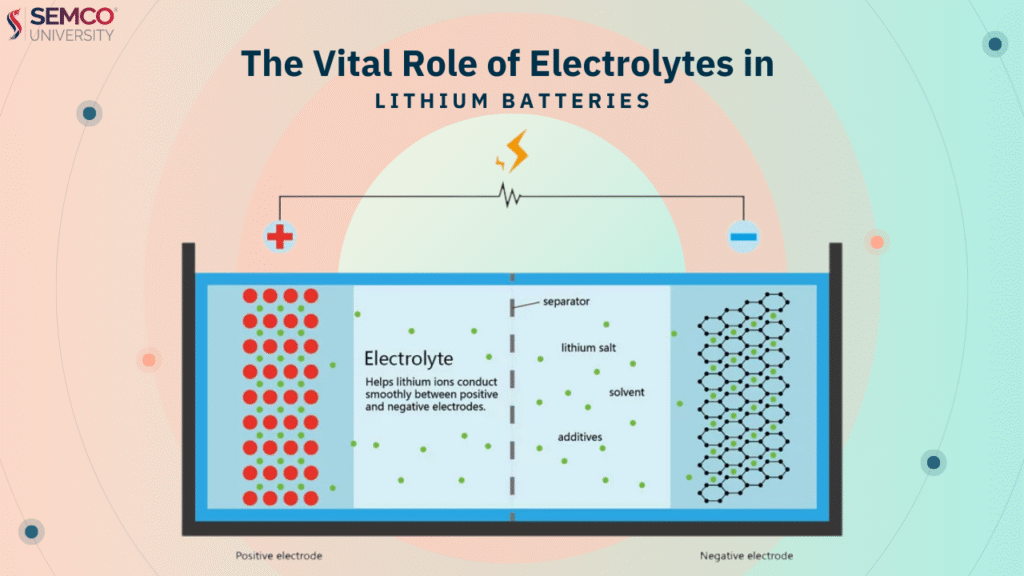The electrolyte is a critical, yet often understated, component within lithium batteries. Functioning as the medium for ion transport between the positive and negative electrodes, its composition and properties directly dictate the battery’s overall performance, safety, and lifespan.
Typically, a lithium battery electrolyte is a carefully engineered mixture of high-purity organic solvents, electrolyte lithium salts, and a small but crucial percentage of performance-enhancing additives, all prepared under controlled conditions and precise ratios. While solvents constitute the bulk of the electrolyte by volume (80-85%), the lithium salts, though present in smaller quantities (10-12%), often represent the largest portion of the electrolyte’s cost (40-50%). Additives, making up a minor fraction by volume (3-5%), can account for a significant share of the cost (10-30%) due to their specialized functions.
The Key Ingredients: Solvent, Lithium Salt, and Additives
- Solvent: The Ion Highway: The solvent provides the essential liquid environment that allows the electrolyte lithium salt to dissolve and the lithium ions to move freely. In the early days of battery technology, water was considered as a potential electrolyte solvent. However, given that lithium batteries operate at voltages significantly higher than the electrochemical stability window of water (around 1.2V), organic solvents have become the standard for commercial lithium batteries. Currently, a blend of carbonate solvents, primarily dimethyl carbonate (DMC), ethylene carbonate (EC), and ethyl methyl carbonate (EMC), constitutes about 95% of the solvents used. These solvents are chosen for their desirable characteristics, including a high dielectric constant (facilitating salt dissolution), low melting point and high boiling point (ensuring a wide operating temperature range), low viscosity (promoting ion mobility), and good chemical stability (preventing unwanted reactions).

2. Lithium Salt: The Source of Charge Carriers: The lithium salt is the most critical and often the most expensive component of the electrolyte. As the solute, it dissolves within the solvent to release a high concentration of mobile lithium ions, which are essential for the electrolyte’s conductivity. Among various lithium-containing compounds, lithium hexafluorophosphate (LiPF6) stands out due to its excellent all-around performance and strong market dominance. It is currently the most widely used solute, although newer lithium salts like lithium bis(fluorosulfonyl)imide (LiFSI) are being explored as potential future replacements. Lithium hexafluorophosphate exhibits high electrical conductivity, a favorable lithium ion transference number (indicating efficient ion transport), strong electrochemical stability, and good resistance to oxidation. Furthermore, it facilitates the formation of a suitable Solid Electrolyte Interphase (SEI) film on the carbon negative electrode, effectively passivates the aluminum current collector on the positive electrode side, and is compatible with a wide array of positive and negative electrode materials.
3. Additives: The Performance Enhancers: Additives are specialized substances incorporated into the electrolyte in small quantities to impart specific functionalities and significantly enhance the battery’s electrochemical performance. Based on their mode of action, they can be broadly categorized into film-forming additives (to improve the SEI layer), overcharge protection additives (to prevent damage from excessive charging), high/low temperature additives (to broaden the operating temperature range), flame retardant additives (to improve safety), and rate capability additives (to enhance performance at high charge/discharge rates).
The Most Popular Choice: Lithium Hexafluorophosphate (LiPF6)
Lithium hexafluorophosphate (LiPF6) reigns as the most commonly used electrolyte in commercial lithium-ion batteries. Its widespread adoption can be attributed to several key factors:
- Market Dominance: LiPF6 currently holds the largest market share among lithium salt electrolytes used in commercial lithium-ion batteries.
- Superior Electrochemical Properties: It exhibits high electrical conductivity, stable electrochemical behavior, and does not corrode the current collectors, ensuring efficient ion transport and reliable battery operation.
- Cost-Effectiveness: The production process for LiPF6 is relatively mature, allowing for large-scale manufacturing and a significant cost advantage compared to many alternatives.
- Broad Applicability: LiPF6 is versatile and suitable for a wide range of lithium battery types, including those used in consumer electronics, electric vehicles, and energy storage systems, further solidifying its dominant position.

While other lithium salts like lithium tetrafluoroborate (LiBF4) also find niche applications in electrolytes, LiPF6 remains the preferred choice due to its overall balance of excellent electrochemical properties, cost-effectiveness, and broad applicability.
Essential Functions and Characteristics of the Electrolyte
As the crucial medium for ion transport, the electrolyte performs several vital functions and possesses key characteristics:
- Ion Conduction: The primary role of the electrolyte is to facilitate the movement of lithium ions between the positive and negative electrodes during both the charging and discharging processes, enabling the battery to store and release energy.
- Stability Maintenance: The electrolyte must maintain its stability within the electrochemical environment of the battery, effectively preventing the deposition of solid lithium ions (lithium plating) and ensuring the battery’s long-term cycle life and consistent charge-discharge performance.
- Heat Dissipation and Cooling: Lithium batteries generate heat during operation. A good electrolyte possesses excellent thermal conductivity, aiding in heat dissipation and contributing to the overall thermal management and stability of the battery.

Beyond these core functions, an ideal electrolyte should also exhibit high electrical conductivity, excellent chemical stability (remaining inert to other battery components), a wide electrochemical potential window (allowing for high operating voltages), a broad operating temperature range, and environmental compatibility.
Applications and Future Outlook
Lithium battery electrolytes are integral to a vast array of applications, powering mobile devices, electric vehicles, energy storage systems, and more. With the rapid expansion of the electric vehicle industry and the continuous advancements in energy storage technologies, the demand for high-performance batteries is steadily increasing. This growing demand is driving continuous innovation and development in lithium battery electrolyte technology. The future promises further advancements through the exploration and implementation of novel lithium salts, innovative solvents, and high-performance additives. These developments will further enhance the performance characteristics of lithium battery electrolytes, providing crucial support for the continued growth and evolution of the lithium battery industry and its vital role in a sustainable energy future.
In conclusion, the lithium battery electrolyte, though often unseen, is an indispensable and critical component. Its performance directly dictates the overall capabilities and application scope of lithium batteries. Therefore, meticulous attention to the selection and preparation of the electrolyte is paramount in the research, development, and production of high-performing and reliable lithium batteries.

